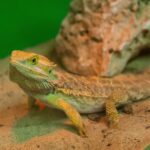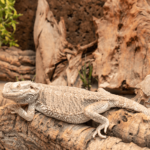Proper lighting is essential for keeping a healthy bearded dragon. Without the right lights, beardies can suffer from metabolic bone disease and other health problems. This bearded dragon lighting guide will provide you with all the information you need to ensure your pet gets the proper light exposure and stays healthy.
We’ll cover topics such as:
- What UVB bulbs and which ones are best for bearded dragons
- How to position UVB bulbs correctly in your tank
- What’s the best setup for a basking lamp
- Creating a temperature gradient
- Plenty of other tips that will help you create an optimal environment for your bearded dragon!
With this guide, you’ll be able to set up a habitat that provides everything they need! So grab your sunglasses and et’s get started, shall we?
Existing beyond the spectrum of visible lights, UVB rays are undetectable to the human eye. Nevertheless, they are essential to the health of your bearded dragon.
Bearded dragons require UVB rays in order to produce Vitamin D3. Without it, they can’t absorb and use calcium, leading to the development of metabolic bone disease, a nasty affliction that can cause growth problems and disfiguration.

The first step in setting up your bearded dragon’s habitat is to choose the right fixtures for their UVB bulbs.
When it comes to UVB bulbs, you essentially have two options: T5 UVB bulbs and T8 UVB bulbs. The two models differ in diameter and output.
T5s output more UVB than T8s, so they can be placed further away from your bearded dragon and mounted outside the tank. A T5 can be positioned about the mesh top to your beardie’s enclosure
T8 bulbs on the other hand, output less UVB and must be placed inside the tank to guarantee they are supplying enough UVB for your beardie. You can usually mount them with a simple command strip on the top or side of the tank.
It’s important to note that regardless of the type you choose, the bulb should cover between 2/3 and 3/4 of the tank. This guarantees plenty of rays for your beardie to soak up, while still allowing for a shady escape if needed.
The ideal distance between the UVB bulb and floor of the tank should be between 12-18 inches. This is because UVB rays have a limited range, and in order to reach the bearded dragon they should be placed at just the right height. If the UVB bulb is too high, the rays won’t penetrate down far enough and your beardie won’t get the required exposure.
Additionally, it’s a good idea to invest in fixtures with reflectors to ensure that your pet is getting the maximum amount of UVB possible! This is especially true if you have a T5 bulb is mounted outside the enclosure and is shining through a mesh top. The mesh stops some of the UVB rays from getting into the tank. A reflector will help to maximize the output.
 The ideal bearded dragon lighting positions a basking lamp at one end of the tank, and a UVB light that reaches about two-thirds of the tank
The ideal bearded dragon lighting positions a basking lamp at one end of the tank, and a UVB light that reaches about two-thirds of the tank
In addition to the UVB bulb, your bearded dragon needs a basking lamp. This fixture provides warmth and will help regulate the temperature of their tank.
It’s vital that you position the basking lamp at one end of the tank, not in the middle. This will create a “hot side” and a “cool side”, allowing your bearded dragon to move between the two environments as needed. The resulting “temperature gradient” will allow your beardie to warm himself up or cool himself down to regulate his body temperature.
Temperature gradient = a habitat with a warm side (where the basking lamp is) and cool side (the opposite side of the tank from the basking lamp).
You should also have a basking spot set up directly underneath the basking lamp, raised off the floor and offering closer proximity to the lamp. A flat rock or a log make the ideal lounge chair for your lizard to soak up the heat of their beloved basking lamp.
It’s important to use a thermometer to monitor temperatures in the enclosure. You want to make sure that your bearded dragon is comfortable, with temperatures ranging from 95–105°F on the hot side and 80–90°F on the cool side.
Note: Baby and juvenile bearded dragons require a slightly warmer temperature of up to 115°F on the hot side and 95°F on the cool end. The temperature in the tank should be gradually decreased as your beardie approaches adulthood.
 Setting up a basking lamp at one end of the tank creates a proper temperature gradient
Setting up a basking lamp at one end of the tank creates a proper temperature gradient
When it comes to your basking lamp, you’ll want to invest in a mercury vapor bulb or an incandescent spotlight. Both of these fixtures can provide UVA and heat — the two things your bearded dragon needs to stay healthy and happy.
A halogen bulb or incandescent spotlight produce a decent amount of heat; a bulb of 90–100 watts will keep the tank plenty warm.
If you’re using a fluorescent bulb, you’ll need to up the wattage to somewhere around 120 or 150 watts. These bulbs don’t produce as much heat, so you’ll have to compensate with a more powerful bulb.
If you’re having trouble keeping the tank warm enough during cold winter months, you may want to invest in a ceramic heat emitter. This fixture is mounted up high above the tank and emits infrared heat.
The emitter should never be placed inside the enclosure, as it can easily become too hot for your bearded dragon to handle. Position it on the outside of the tank, directed downward towards the middle of the tank or basking area.
A ceramic heat emitter is only necessary if the room temperature drops below 70°F. Rooms this cold suck a lot of heat out of your beardie’s tank. Make sure you’re using a thermometer to monitor temperatures in the tank, and adjust your heat sources as needed.
Your bearded dragon should get 12–14 hours of intense light each day from the combination of both the UVB bulb and basking lamp. The best way to achieve this is by using a timer for your lights, setting it to turn on at least 12 hours per day.
Any more than the recommended 12–14 hours of light can put too much stress on your bearded dragon. Any less can result in a variety of health problems and an unhappy lizard.
And don’t forget that during the summer months, natural sunlight should be taken into account when setting up a lighting schedule for your beardie’s tank. If you have windows in the room where their tank is located, make sure to adjust the lighting schedule accordingly. It’s best to match your beardie’s lighting schedule with the sun’s natural cycle.

No, your bearded dragon should not have a light on at night. Like all reptiles, they need darkness to regulate their circadian rhythms (aka body clock) and get proper rest. A consistent dark period of 10–12 hours every night is the best way to ensure your beardie’s health and happiness.
You’ll see a variety of red and blue lights on the market. These lights emit a low level of light and are marketed as being safe for nighttime lighting. However, even those low lights can disrupt sleep and throw off a bearded dragon’s day/night cycle.
For the best results, keep your beardie’s tank dark for at least 10–12 hours each night. To make your lizard feel safe, you can provide some natural hiding spots in the tank or add a shallow cave to help them relax (they might even ask you for a sleep mask).
A: Bearded dragons need full-spectrum UVB and UVA lighting as well as a basking lamp to keep the tank warm.
A: Bearded dragons should have 12–14 hours of intense lighting each day — this can come from either natural or artificial sources. The best way to ensure consistent lighting is to use a timer for your fixtures and make sure you adjust it
A: No, your bearded dragon should have a dark period of 10–12 hours every night. Even very dim red and blue lights can disrupt their sleep and throw off their circadian rhythms. Keep the tank dark to give your beardie
A: If the room temperature drops below 70°F, you may want to invest in a ceramic heat emitter to keep your tank warm enough. Make sure it’s mounted up high above the tank and directed downward towards the middle of the tank or
A: UVA and UVB are simply two different wavelengths of light, both of which are invisible to humans. UVA lighting is essential for your bearded dragon’s overall health and wellbeing, as it helps them regulate their circadian rhythms, appetite, and mood. UVB lighting is necessary to help with calcium absorption in their body. Both types of light are important, so make sure you have both in your tank.
In review, here’s what we have learned about the best lighting for a bearded dragon tank:
- Bearded dragons need full-spectrum UVA and UVB lighting, as well as a basking lamp to keep their tank warm.
- To ensure consistent light exposure, use a timer to turn the lights on for 12–14 hours each day. During the summer months, account for natural sunlight when setting up the schedule.
- To give your beardie some peace and quiet, keep the tank dark for 10–12 hours at night.
- If the room temperature drops below 70°F, you may need a ceramic heat emitter to supplement their warmth needs.
- Positing your lights properly is critical. Stronger bulbs should be mounted above the tank, while weaker bulbs should be set up inside the tank closer to the bottom of the enclosure.
Once you know the essentials, setting up your bearded dragon’s tank with the right lighting doesn’t seem so scary. You’ll be able to provide your beardie with the right light and temperature levels it needs to stay happy and healthy.
Now, you can go ahead and enjoy watching your scaly little buddy as they bask in the comfort of their habitat (and work on that summer tan)!

![The Ultimate Bearded Dragon Lighting Guide [Perfect Uvb Setup]](https://reptile.guide/wp-content/uploads/2020/01/Bearded-Dragon-Light-Diagram.jpg)




:max_bytes(150000):strip_icc()/13-f9fc54bc64854d20b43e00db91a9cb16.jpg)